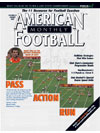AMERICAN FOOTBALL MONTHLY THE #1 RESOURCE FOR FOOTBALL COACHES
Article CategoriesAFM Magazine
|
The Northwestern One-Two Punch vs. Cover 3by: Eric EvansOffensive Graduate Asst., Northwestern University © More from this issue There are thousands of great coaches in this wonderful profession and we are very humbled to be able to write about our offense. In 2005 we finished fourth nationally in total offensive production. The plays we’ve included in this clinic had been a major part of our success and have been a staple in the Wildcat offense since the implementation of the Spread Offense in 2000. Attacking Cover 3 At Northwestern we see a lot of different coverages. However, one of the most common coverages that we face is Cover 3. Against a Cover 3 defense we like to attack the flat defenders as well as the deep free safety. We feel that we can pick up quick chunks of yards against the flat coverage linebackers. We also know that we can attack the free safety deep down the field for a big gain. We are going to share two of our plays that specialize in beating Cover 3 from our two wide receiver, two tight end and one back personnel group. The two routes that we are going to talk about are the slant and the slant burst. Cat Formation For the purpose of this article we will talk about each route from our Cat formation. Our Cat formation consists of two wide receivers, two tight ends, and one tailback. Our wide receivers and tight ends will split to a 2x2 formation, with the Z being the outside receiver to the field and the X the outside receiver to the boundary. The Y-TE will be the tight end to the field and the S-TE will become the tight end to the boundary. Our quarterback will align in the Gun and the tailback will align to the field (See Diagram 1).
Slant The Slant combination is a simple route that is used to beat a single safety defense, for example, as in Cover 3. We like to attack the flat defender in our slant combination. Our outside receivers will take a max split. The X and Z are taught to run vertical for three steps and break to the inside at a 45 degree angle. If run correctly, the outside receiver will plant off his outside foot when he breaks in. This is what we call a second level slant. The depth of the route will be between 8-10 yards deep. Our tight ends are taught to run a flat route. The Y and S will run at an angle and banana out to the sideline at a depth of four yards. It is key for the tight ends to snap their heads around quickly in order to catch a quick throw from the quarterback. The quarterback’s drop is as follows: he will catch, take a one step shuffle and throw. The quarterback is taught to throw off the movement of the flat defender. If the flat defender shoots to the flat, the quarterback will throw the slant behind the flat defender. However, if the flat defender drops into coverage and takes away the alley for the slant, the quarterback will throw outside to the flat route by the tight ends (See Diagram 2).
Slant Burst The next concept that we are going to discuss is our Slant Burst. The Slant Burst is a great complement to our Slant route. Our receivers and tight ends are taught to run the exact same route as they would on our slant combination. However, on the Slant Burst, our outside receivers are taught to burst down the field on their third step of the slant route after their break at a 45 degree angle. Our X and Z receiver will burst down the field from a distance of two yards outside the hash. Our tight ends are going to run what we call wheel routes. They are going to run the same flat route, making sure to snap their heads back to the quarterback. They will then turn and run down the sideline, aiming about four yards away from the sideline. The quarterback’s drop consists of catch, turn, pump to the slant, then utilize a three step drop from his gun alignment. This will allow the receivers time to get down the field and will help the linebackers and safeties bite on the slant. The quarterback will read the Cover 3 – Deep Free Safety. The read for the quarterback is the same as his read on a 4 Vertical Concept. If the FS jumps the boundary Slant Burst, the quarterback will throw to the Z on the field Slant Burst. If the FS jumps the Slant Burst from the field, the Quarterback will throw to the X receiver coming from the boundary. The quarterback wants to hit the Slant Burst on a line at about 18 yards down the field. This is a simple play that can generate a lot of yards and production (See Diagram 3).
End Zone This is just a small piece of our offensive attack but it has proven to be a dangerous weapon. These routes have produced a high completion percentage and they are easy to teach to all positions of the offense. In order to be successful we need to get the ball in the hands of our best players. As you can see, these two plays allow us to spread the field and get the ball to a number of different playmakers. |
|
| HOME |
MAGAZINE |
SUBSCRIBE | ONLINE COLUMNISTS | COACHING VIDEOS |
Copyright 2024, AmericanFootballMonthly.com
All Rights Reserved







